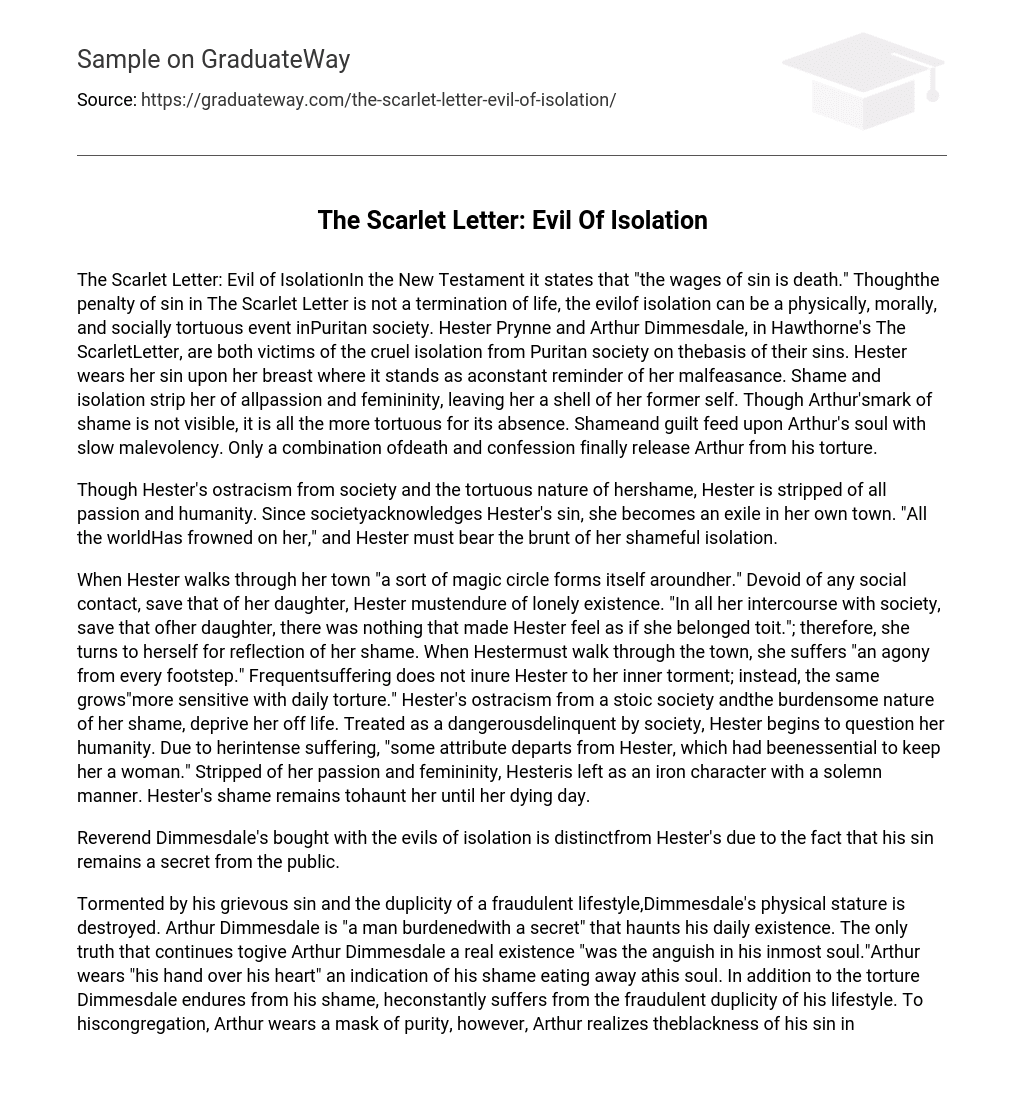The Scarlet Letter: Evil of IsolationIn the New Testament it states that “the wages of sin is death.” Thoughthe penalty of sin in The Scarlet Letter is not a termination of life, the evilof isolation can be a physically, morally, and socially tortuous event inPuritan society. Hester Prynne and Arthur Dimmesdale, in Hawthorne’s The ScarletLetter, are both victims of the cruel isolation from Puritan society on thebasis of their sins. Hester wears her sin upon her breast where it stands as aconstant reminder of her malfeasance. Shame and isolation strip her of allpassion and femininity, leaving her a shell of her former self. Though Arthur’smark of shame is not visible, it is all the more tortuous for its absence. Shameand guilt feed upon Arthur’s soul with slow malevolency. Only a combination ofdeath and confession finally release Arthur from his torture.
Though Hester’s ostracism from society and the tortuous nature of hershame, Hester is stripped of all passion and humanity. Since societyacknowledges Hester’s sin, she becomes an exile in her own town. “All the worldHas frowned on her,” and Hester must bear the brunt of her shameful isolation.
When Hester walks through her town “a sort of magic circle forms itself aroundher.” Devoid of any social contact, save that of her daughter, Hester mustendure of lonely existence. “In all her intercourse with society, save that ofher daughter, there was nothing that made Hester feel as if she belonged toit.”; therefore, she turns to herself for reflection of her shame. When Hestermust walk through the town, she suffers “an agony from every footstep.” Frequentsuffering does not inure Hester to her inner torment; instead, the same grows”more sensitive with daily torture.” Hester’s ostracism from a stoic society andthe burdensome nature of her shame, deprive her off life. Treated as a dangerousdelinquent by society, Hester begins to question her humanity. Due to herintense suffering, “some attribute departs from Hester, which had beenessential to keep her a woman.” Stripped of her passion and femininity, Hesteris left as an iron character with a solemn manner. Hester’s shame remains tohaunt her until her dying day.
Reverend Dimmesdale’s bought with the evils of isolation is distinctfrom Hester’s due to the fact that his sin remains a secret from the public.
Tormented by his grievous sin and the duplicity of a fraudulent lifestyle,Dimmesdale’s physical stature is destroyed. Arthur Dimmesdale is “a man burdenedwith a secret” that haunts his daily existence. The only truth that continues togive Arthur Dimmesdale a real existence “was the anguish in his inmost soul.”Arthur wears “his hand over his heart” an indication of his shame eating away athis soul. In addition to the torture Dimmesdale endures from his shame, heconstantly suffers from the fraudulent duplicity of his lifestyle. To hiscongregation, Arthur wears a mask of purity, however, Arthur realizes theblackness of his sin in private. Dimmesdale endures a constant “bitterness andagony of heart” from the “contrast between what he seems and what he is”Due to his multiple lifestyles, Dimmesdale is often “bewildered as to which maybe true.” The sum of Dimmesdale’s torment is manifested in the form of a “bodilydisease,” which serves to deteriorate the reverend. Dimmesdale is only able tofind peace in death and confession. Revealing his sin to society, he freeshimself to advance toward God’s judgment.
The evil of isolation of Puritan society robs Hester and Dimmesdale oftheir humanity, leaving them as stone monuments of shame. The isolation ofPuritan society is a result of their belief that “the wages of sin is death.”Only in death do Hester and Dimmesdale escape the anguish that arises fromisolation. However, the infancy remains as their “only monument” after death.
The destructive nature of shame is a powerful weapon.





